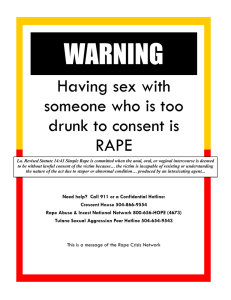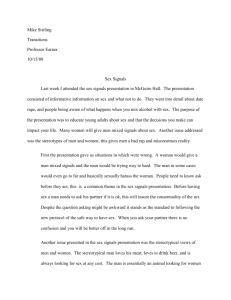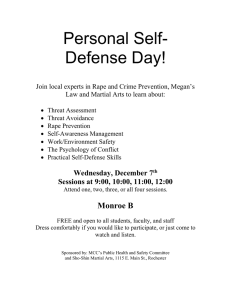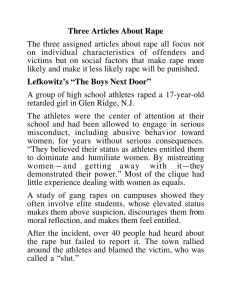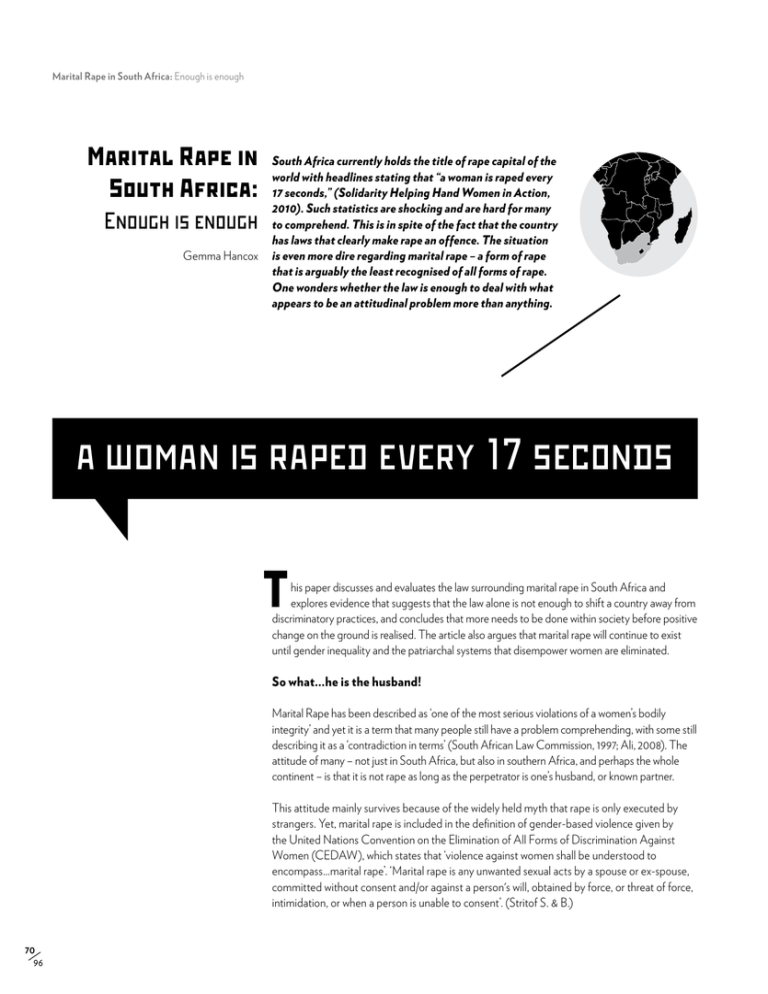
Marital Rape in South Africa: Enough is enough
Marital Rape in
South Africa:
Enough is enough
Gemma Hancox
South Africa currently holds the title of rape capital of the
world with headlines stating that “a woman is raped every
17 seconds,” (Solidarity Helping Hand Women in Action,
2010). Such statistics are shocking and are hard for many
to comprehend. This is in spite of the fact that the country
has laws that clearly make rape an offence. The situation
is even more dire regarding marital rape – a form of rape
that is arguably the least recognised of all forms of rape.
One wonders whether the law is enough to deal with what
appears to be an attitudinal problem more than anything.
a woman is raped every 17 seconds
T
his paper discusses and evaluates the law surrounding marital rape in South Africa and
explores evidence that suggests that the law alone is not enough to shift a country away from
discriminatory practices, and concludes that more needs to be done within society before positive
change on the ground is realised. The article also argues that marital rape will continue to exist
until gender inequality and the patriarchal systems that disempower women are eliminated.
So what…he is the husband!
Marital Rape has been described as ‘one of the most serious violations of a women’s bodily
integrity’ and yet it is a term that many people still have a problem comprehending, with some still
describing it as a ‘contradiction in terms’ (South African Law Commission, 1997; Ali, 2008). The
attitude of many – not just in South Africa, but also in southern Africa, and perhaps the whole
continent – is that it is not rape as long as the perpetrator is one’s husband, or known partner.
This attitude mainly survives because of the widely held myth that rape is only executed by
strangers. Yet, marital rape is included in the definition of gender-based violence given by
the United Nations Convention on the Elimination of All Forms of Discrimination Against
Women (CEDAW), which states that ‘violence against women shall be understood to
encompass…marital rape’. ‘Marital rape is any unwanted sexual acts by a spouse or ex-spouse,
committed without consent and/or against a person's will, obtained by force, or threat of force,
intimidation, or when a person is unable to consent’. (Stritof S. & B.)
70
96
With 18.8 percent of South African women admitting to being
subjected to marital or partner rape on one or more occasions,
marital rape is clearly not a myth (Lucas, 2010: 3). The World Health
Organisation’s 2006 study on domestic violence, which encompasses
marital rape, found that intimate partner violence is the most common
form of violence in a woman’s life – much more common than assault
or rape by strangers or acquaintances (World Bank in Soul City 1999:
9). Some have even argued that marital rape causes more lasting
effects than rape perpetrated by a stranger as it not only includes the
physical violation but also the additional violation of trust between
a husband/partner and wife. In addition, given that the nature of the
marital relationship, the rapists often repeat the offence many times
over (Mhlanga, 2007). Research has shown that marital rape survivors
are twice as likely to suffer physical injury compared to rape by
strangers. (Myhill & Allen, 2002, 33)
The high incidence of rape in South Africa owes much to the violent
apartheid system that was in place from 1948-1994 (CEDAW, 1998:
6). Women were the hardest hit by the impacts of apartheid, suffering
both racial and gender discrimination. There were few if any legal
rights for women, who were seen as the property of their husbands;
and to this day, such beliefs are still common in across the country. For
instance, a report by the UN Population Fund showed that ‘the right
of a husband to beat or physically intimidate his wife’ was a ‘deeply
held conviction’ rooted within tradition and that even within societies
where women retain a higher status they would ‘condone or at least
tolerate a certain amount of violence against women’ (UNFPA, 2000,
Chapter 3). Marital rape thus seems to be a way of life within South
Africa, and seldom stimulates the public outrage that it ought to
(Reganass in Armstrong, 1994, 1).
In addition, many myths and stereotypes have surrounded marital
rape and arguably still do. Two significant cases highlight these
and it is clear from the judges’ opinions and decisions that simply
criminalising marital rape is not enough to combat the problem and
that further protection for marital rape survivors is needed. In S v.
Moipolai [2004], Judge Mogoeng, when discussing the complainant’s
visit to the home of the appellant’s parents, stated that she “must
have come knowing that this [sexual intercourse] was either likely to
happen or was going to happen for sure and she was, given the nature
of their relationship, willing to take part in the intercourse.” For a judge
to make such an assumption sends the message that he does not
believe marital rape can occur due to the ‘nature of their relationship’.
This only reinforces the myth that because a woman has previously
consented, she is likely to do so on future occasions, and so further
forced intercourse is not seen to be rape. The judge went on to state
that “this rape should therefore be treated differently from the rape of
one stranger by another between whom consensual intercourse was
almost unthinkable.” (Mogoeng JP, 2007: 24)
Similarly, in S v Modise [2007], Judge Gura stated that “The desire
to make love to his wife must have overwhelmed him, hence his
somewhat violent behaviour…however…minimum force, so to speak,
was resorted to in order to subdue the complainant’s resistance.” He
then went on to conclude that, “This relationship, of husband and wife,
should never be overlooked by any judicial officer.” However, the law
now states that a relationship of husband and wife can no longer be
a mitigating factor and so marital rape must be treated like any other
rape (Criminal Law (Sentencing) Amendment Act, 2007: S.3(aA)).
Reporting rape, particularly marital rape, is not easy for survivors, and
a 2010 Medical Research Council study showed that sexual violence
by an intimate partner was the least often reported – with only 2.1
percent of women experiencing this form of attack saying that they had
reported it. Finkelhor and Yllo (1985) found that marital rape survivors
suffered a number of affects after the incident, including ‘betrayal and
shock that someone who loved them would hurt them in that way,
and feeling that they were to blame’. Several factors, such as a fear
of police, lengthy court cases and many women being unaware that
the forced sex her husband is subjecting her to is a criminal offence,
all contribute to this lack of reporting. Women also fail to report rape
because of their financial dependence on their husbands. One study of
20 wives’ experience of sexual violence by their husbands found that,
within unequal relationships, women sometimes feel obliged to suffer
acts of non-consensual sex with their husbands in return for the food
and shelter that they are provide (Kottler in Mhlanga, 2007). Such
evidence supports the theory that women living in poverty are more at
risk and more vulnerable to such non-consensual sexual acts as they are
generally uneducated and lack financial independence (WHO, 2006).
The introduction of rules within the Criminal Law (Sentencing) Act
2007, which prohibit lesser sentences based on any of the reasons
listed in S.3(aA), also address the myths that surround rape. ‘Violence
Against Women in South Africa, A Resource for Journalists’ discusses
many of these myths with one of the most damaging being that rape
can only be committed by a stranger and a husband cannot rape his
wife (Soul City, 1999). Another myth and one also tackled by the
implementation of these rules is that a woman was not really raped if
she did not fight back and has not suffered any physical injuries.
In addition, in many of the rural villages within South Africa, customary
laws take precedence over national law, resulting in discriminatory
behaviour. One of the prime examples and linked to marital rape is
the customary practice of lobolo. This is paid by the husband or his
family to his new wife’s family, and a husband then believes his wife
becomes his property. Such a practice can make a woman vulnerable
to domestic violence, decreasing her ability to resist or flee abusive
situations, while her husband may use it as justification for this abuse
(Curran & Bonthuys, 2004; S.2.3).
BUWA! A Journal on African Women's Experiences
71
96
Marital Rape in South Africa: Enough is enough
One case that highlighted the problem with lobolo was the
case of S. v. Mvamvu (2004), in which the complainant did not
reimburse her husband for the lobolo he had paid when she
decided to leave him. As such, the husband believed that they
were still married when he kidnapped and raped her. The judge
recognised that “his actions, though totally unacceptable in law...
were shaped and moulded by the norms, beliefs and customary
practices by which he lived his life” and that “the complainant’s
rights to bodily integrity and dignity and her entitlement to
have these rights respected and protected were not foremost
amongst his concerns” (Mthiyane JA, 2004; [16]).
This case was heard in 2007, and Judge Mthiyane held that
the court was entitled to depart from the mandatory minimum
life sentence because there was the probability that they were
still married under customary law and that he believed he had
some right to ‘conjugal’ benefits. The judge gave a lot of weight
to customary traditions, even though they were discriminatory
and the complainant’s basic human rights had been violated.
The judge offered no comfort but only lessened the appellant’s
sentence, sending a negative message to other men that they
could get away with abusing their wives on account of lobolo.
Hope is born as laws are enacted, reformed and amended
For a long time, there was no hope for married women regarding rape,
as it was sanctioned by law, and condoned by culture and social norms.
The law then recognised other forms of rape, except for marital rape.
This meant that consent was an irrevocable part of a marriage contract
as illustrated in this statement – “A husband cannot be found guilty of
raping his wife, by reason of her consent in marriage” (R v Gumede,
1946). This gave men power to legally force their wives to have sex
with them, whenever they wished, with impunity. This legal status
bred the attitude that marital relations are a private matter and should
be dealt with at home; family and friends rarely got involved either
(Wandia in Kimani, 2007: 4). Culture and social norms sealed the
fate of women in that, once married, women were offered very little
protection, legal or otherwise, from their sexually abusive husbands.
It was not until 1993 that South Africa passed the Prevention of
Family Violence Act, which, among other things, criminalised
marital rape. The law stated that “Notwithstanding anything to the
contrary contained in any law or in the common law, a husband may
be convicted of the rape of his wife.” South Africa became one of
the first countries within Africa – and one of the few members of the
15-member Southern African Development Community (SADC) –
to criminalise marital rape. The question is, whether this has changed
the situation of married women significantly?
72
96
One would expect that with such a law – along with a world class
Constitution that was enacted a few years later in 1996 to ‘heal the
divisions of the past and establish a society based on democratic
values, social justice and fundamental human rights’ (Preamble
of the Constitution of the Republic of South Africa, 1996 Act 108
1996) – marital rape would be a thing of the past. Indeed, since the
introduction of the Constitution, the law regarding marital rape
has continued to be amended and improved with the Criminal Law
(Sexual Offences and Related Matters) Amendment Act, No 32 of
2007. The criminalisation of marital rape – and the elimination of a
defence to such action – means that marital rape is now incorporated
into the offence of rape, which is governed by this Act. The Act
confirms the country’s legal status on marital rape stating that “it is
not a valid defence for an accused person to contend that a marital
or other relationship exists or existed between him or her and the
complainant.” The Act also improved the definition of rape so that
‘penetration’ now includes ‘into or beyond the genital organs, anus,
or mouth of another person’ using the ‘genital organs [or] any other
part of the body of one person or, any object, including any part of the
body of an animal’.
It was through this same Act that the controversial ‘cautionary
rule’ was abolished. For a long time, the cautionary rule allowed
a judge the freedom to apply caution to the credibility of a rape
survivor, particularly when her testimony was not corroborated,
which rarely happens in rape cases. However, S.60 of the Criminal
Law (Sexual Offences and Related Matters) Amendment Act now
states that “Notwithstanding any other law, a court may not treat
the evidence of a complainant in criminal proceedings involving the
alleged commission of a sexual offence pending before the court,
with caution, on account of the nature of the offence.” S.59 of the
same Act also attempts to protect survivors stating that “In criminal
proceedings involving the alleged commission of a sexual offence,
the court may not draw an inference only from the length of any delay
between the alleged commission of such offence and the reporting
thereof.” This means that victims cannot be treated differently for not
reporting an incident immediately.
With marital rape having been criminalised for over 14 years, South
Africa introduced the Criminal Law (Sentencing) Amendment Act
2007, which offered minimum sentencing guidelines for rape, along
with unsatisfactory and prohibited reasons for justifying a lesser
sentence. S.3(aA) states that “When imposing a sentence in respect
of the offence of rape the following shall not constitute substantial and
compelling circumstances justifying the imposition of a lesser sentence:
(i) The complainants previous sexual history: (ii) an apparent lack of
physical injury to the complainant (iii) an accused person’s cultural or
religious beliefs about rape or (iv) any relationship between the accused
person and the complainant prior to the offence being committed.”
It is worth noting that in comparison to some of its neighbouring
countries, South Africa is setting a good example in eliminating
discriminatory laws and promoting equality for women throughout its
legal framework. In terms of marital rape, South Africa is one of the few
SADC countries to have criminalised it – others include Zimbabwe,
Lesotho, Namibia, Seychelles and Tanzania. Malawi, for instance, only
defines rape outside of the marriage context despite the fact that
75 percent of married women in the country have admitted to being
raped by their husbands (White, in BBC News, 2001). In a number of
other southern African countries, women’s groups advocating for the
criminalisation of marital rape are have been told by policy makers and
traditional leaders that it would be difficult to convince the ‘ordinary man
on the street’ that having sex with his ‘lawfully wedded’ wife can ever be
rape (Ali N, 2008). Mozambique has adopted several laws to eliminate
gender discrimination and violence but they have failed to include
marital rape within their law on domestic violence.
What still needs to be done in South Africa?
Despite South Africa’s progressive laws, the country still has a huge
problem regarding marital rape. In June 2009, figures released by
the Medical Research Council showed that 14.3 percent of men had
disclosed the rape of a current or ex-girlfriend. As recently as 2010,
the Medical Research Council reported that 18.8 percent of women
admitted to being subjected to marital/partner rape on one or more
occasion, with a similar figure of 18.2 percent of men admitting to
forcing their current or ex partners or wives to have sex when they
did not want to (Lucas, 2010, 4). The rise in these figures over time is
significant and could be because more women are able to admit when
they have been subjected to marital rape and/or because of a rise in
the prevalence of the offence. Either way, these statistics show that
despite the introduction of laws criminalising marital rape, there is still
a lot of work that needs to be done beyond the legal sphere to tackle
South Africa’ shockingly high rates of marital rate.
There is a need to focus on society and shift peoples’ perspectives
and attitudes. Sex stereotypes must be eliminated as these are part
of the reason behind marital rape and discrimination against women
(Gonzalez in CEDAW, 2002:9). Education and awareness for
men and women are key to combating marital rape. The media are
invaluable for such a purpose – with journalists having ‘the power to
dramatically impact the perceptions and worldviews of their target
audiences’ since their reports can ‘shape understandings of particular
crimes and also affect attitudes towards both the survivors and
perpetrators of violence’ (Boswell, 2003: 2; Soul City, 1999:4). The
study found that media articles largely reinforced myths about rape
and that survivors were given little empathy. Indeed, they were often
blamed for the rape. Therefore, there is an urgent need for media to
be more sensitive.
More work also needs to be done in rural areas, where many people’s
lives are still guided by culture and tradition. There is need for
comprehensive research to inform how South Africa can change
attitudes and behaviours, which are shaped by discriminatory
traditional and customary practices. More support groups and
organisations are needed to raise awareness on women’s rights within
these rural areas, as well as offer support to women who need it.
Additional training is also required for police officers since there have
been countless reports from survivors of police insensitivity when
they report that they have been raped – a fact that discourages other
survivors from coming forward (Human Rights Watch, 1995:7).
Conclusion
Eliminating marital rape begins with a country recognising the need
for general equality and the rights of women. South Africa is one of
the leading democratic states in Africa and has managed to enact
progressive laws in relation to violence against women (Chamuka,
2011). This is a historical step in eliminating violence against women.
However, the question still remains whether laws alone are enough, as
incidents of marital rape seem to be on the increase.
In practice, ‘law can reflect social change, even facilitate it, but can
seldom if ever initiate it’ and amending or creating a law is only
a small positive step on the path towards eliminating individual
problems (Fineman, 1991). It has been suggested that ‘criminal justice
systems are probably the least effective institutions to look to for
transformative change’ and this has arguably been proved within
South Africa as the statistics show a very different picture to the
progress made in terms of enacting equality laws and policies (Snider,
1998: 11). Indeed, since ‘violence against women…is deeply embedded
in cultures around the world – so much so that millions of women
consider it a way of life’ (Hopkins in Kimani, 2007: 4), it is crucial to
focus on education and awareness-raising among the next generation
in order to really turn the tide and end the plight of women who are
raped in the context of marriage.
Gemma Hancox graduated from the
University of the West of England in
2009 with an L.L.B Honours in Law. She
volunteered her time at the Projects
Abroad Human Rights Office, Cape
Town South Africa. She currently
spends time working with disadvantaged
communities in Cape Town to promote
and raise awareness on human rights.
BUWA! A Journal on African Women's Experiences
73
96
Marital Rape in South Africa: Enough is enough
Bibliography – Books, Journals, Articles, Reports
Ali N., August 18 2008, The Costs of Marital
Rape in Southern Africa, The Independent (UK).
Armstrong S., June 1994, Population and
Reproductive Rights – Rape in South Africa: an
Invisible Part of Apartheid’s Legacy, Focus on
Gender, Vol. 2, No.2
Artz L. & Smythe D., 2007, Feminism vs. the
State?: A Decade of Sexual Offences Law
Reform in South Africa
Boswell B., 2003, Representation of GenderBased Violence in the Media: A case study of
Two Cape Town Newspapers, 2003
Chamuka Takura, 17 August 2011, The SADC
Gender Protocol: Are the 2015 Objectives
Achievable?, Ngo Pulse
Committee on the Elimination of Discrimination against Women, 2002, Summary Record of
the 390th Meeting – Consideration of Reports
Submitted by South Africa
Curran, E. & Bonthuys E., October 2004, Customary Law and Domestic Violence in Rural
South African Communities, Centre for the
Study of Violence and Reconciliation
Fineman MA (1991) ‘Introduction’. In MA Fineman and NS Thomadsen (1991) ‘At the Boundaries of the Law’, London: Routledge
Finkelhor, D and Yllo, K., 1985, License to Rape
Sexual Abuse of Wives, The Free Press, New York
Henrica A.F.M. Jansen, March 2006, WHO
Multi-Country Study on Women's Health and
Domestic Violence against Women - Initial
results on prevalence, health outcomes and
women's responses, Department of Gender,
Women and Health
Human Rights Watch, Violence Against Women in South Africa: State Response to Domestic
Violence and Rape, 1 November 1995
74
96
Cases
Kilmani M., July 2007, Taking on Violence
Against Women in Africa, Africa Renewal, Vol.
21 No. 2
Lucas Debi, 2010, The War at Home – Preliminary Findings of the Gauteng Gender Violence
Prevalence Study, Gender Links and the Medical Research Council.
Mhlanga Pamela, 2007, Southern Africa:
Justice for survivors of marital rape, how far has
SADC come? Pambazuka News, Issue 332
Myhill A. and Allen J., March 2002, Home
Office Research Study 237 - Rape and sexual
assault of women: the extent and nature of the
problem. Findings from the British Crime Survey, Development and Statistics Directorate
Pettifor A.E., Measham D.M., Rees H.V. and.
Padian N.S., November 2004, Emerging Infectious Diseases – Sexual Power and HIV Risk,
South Africa, Vol. 10, No. 11
Solidarity Helping Hand Women in Action, Media Statement, 29 November 2010, http://www.
helpinghandfund.co.za/media-statements/awoman-raped-every-17-seconds-in-sa/
Soul City Institute for Health and Development
Communication, 1999, Violence Against Women
in South Africa – A Resource for Journalists
Soul City, February 2003, Rape in South Africa
– The ‘Soul City’ Research Report, Rape Crisis
South African Law Commission, 1997, Discussion
Paper 70 Project 100 on Domestic Violence.
Stritof S. & B., Marital Rape Definition, About.
com Guides
United Nations Population Fund UNFPA, 2000,
State of World Population, Chapter 3, http://
www.unfpa.org/swp/2000/english/index.html
White, S, in BBC News, 26 December 2001
R v Gumede 1946 (1) PH H68 (N) Hathorn JP
S v. Mvamvu (350/2003) [2004] ZASCA 90,
[2005] 1 AU SA 435 (SCA)
S v. Moipolai (CA 53/2004) [2004] ZANWHC
19
S v. Modise (113/06) [2007] ZANWHC 73
Law
Prevention of Family Violence Act 1993, No.
133 of 1993
The Constitution of the Republic of South
Africa 1996, Act No. 108 of 1996
Criminal Law (Sexual Offences and Related
Matters) Amendment Act No 32 of 2007
Criminal Law (Sentencing) Amendment Act
2007, No. 38 of 2007

